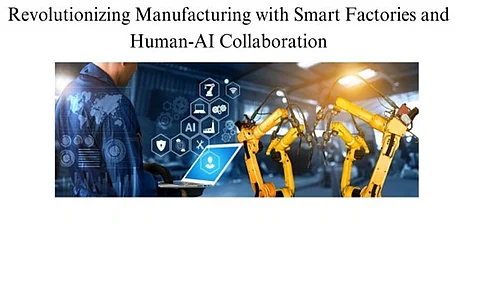

The manufacturing sector is undergoing a major transformation with AI integration into factory operations. Smart factories are boosting efficiency and promoting collaboration between humans and AI, where human expertise combined with machine learning drives unprecedented manufacturing excellence. Aman Jain's work delves into this shift, highlighting how human-AI collaboration is reshaping manufacturing systems for a more efficient and sustainable future.
AI adoption in manufacturing, specifically by AI-based Manufacturing Execution Systems (MES), has significantly enhanced efficiency and quality. Predictive maintenance lowers downtime by 70%, while real-time data analytics enhance operator decision-making, which raises Overall Equipment Effectiveness (OEE) by 31%.
One of the major developments in intelligent manufacturing is the use of AI-based quality control systems. Conventional techniques tended to include slow checks and increased defect rates, but AI-based visual inspection systems can handle 1,200 frames per second. These systems identify defects of even the slightest measurement with close to perfect accuracy, enabling experts to concentrate on intricate patterns. Consequently, defect detection accuracy rises by 43%, saving material, lowering costs, and sustaining high production levels.
One of the greatest advantages of AI-powered manufacturing systems is their beneficial influence on the workforce. Since AI performs repetitive tasks, human workers have the flexibility to redirect their activities towards better decision-making and process improvement. Research indicates that these developments have contributed to a 32% boost in job satisfaction and a significant reduction in workplace injuries. By offloading dangerous and monotonous tasks to AI, employees are able to engage in more meaningful work, which contributes to a healthier, more motivated workforce. Additionally, the collaboration between AI and human workers is driving skill development, as operators increasingly take on roles in system optimization and predictive maintenance.
AI’s contribution to smart factories extends beyond maintenance and quality control. Predictive scheduling, fueled by machine learning algorithms, has revolutionized production planning. The systems monitor big data from IoT sensors in real time, making sure that resources are efficiently allocated and production schedules are optimized. Consequently, unplanned downtime has been reduced by almost 45%, and resource allocation efficiency has been enhanced by almost 40%. This adaptive method of scheduling enables harmonious adjustment to varying demands of production so that factories run at their optimum capacity at all times.
Adaptive process control, too, is being adopted by smart factories, under which AI systems continuously keep a tab on thousands of parameters on production lines and change them independently to maintain maximum performance. These systems have minimized process variability by more than 80%, which has led to more uniform product quality and less material waste. The capability of making real-time adjustments with such accuracy guarantees that production processes remain within tight tolerances, enhancing product consistency by almost 50%. In addition, the incorporation of AI has resulted in significant energy savings, making manufacturing not only more efficient but also greener.
Perhaps the most thrilling of the new developments in smart factories is the convergence of augmented reality (AR) and AI. AR software, when used with AI analytics, is revolutionizing assembly lines by giving workers real-time, context-specific guidance. This has lowered assembly process errors dramatically and increased the speed at which tasks are performed. By shortening training time by more than 70%, AR tools are making employees proficient much quicker. Additionally, application of motion analysis systems combined with AR has caused a drastic drop in repetitive strain injuries and workplace fatigue, improving the overall efficiency of production further.
Supervisors in smart factories are also gaining from AI-powered dashboards that give them real-time information on performance in operations. Such systems analyze enormous volumes of data every day and present critical metrics in simple visualizations. Supervisors are able to react to operational abnormalities between 80% faster compared to conventional approaches, allowing for faster decision-making and minimizing production holdups. With the addition of predictive maintenance functions to such systems, smart factories have minimized downtime even more, allowing uninterrupted flow of production without unwarranted halts.
In conclusion, the future of manufacturing is inextricably tied to AI, with human-AI collaboration poised to redefine operational excellence. Innovations in smart factories, such as predictive maintenance, quality control, adaptive process management, and augmented reality, are setting new benchmarks for efficiency, sustainability, and workforce empowerment. Aman Jain's work illustrates how this collaboration enhances manufacturing while promoting a more secure, sustainable, and innovative industrial ecosystem. The era of smart factories is just beginning, offering boundless opportunities for innovation.
